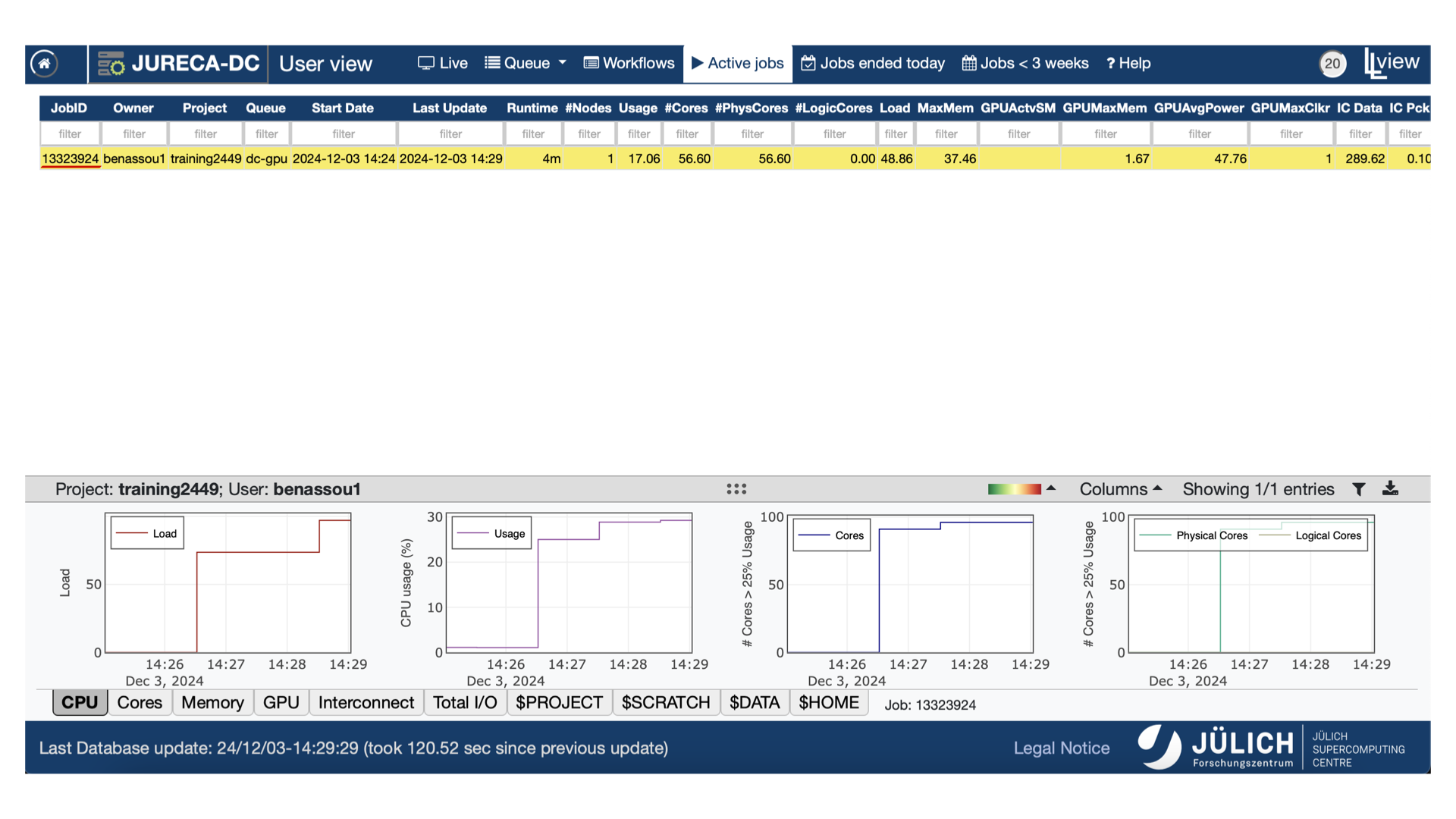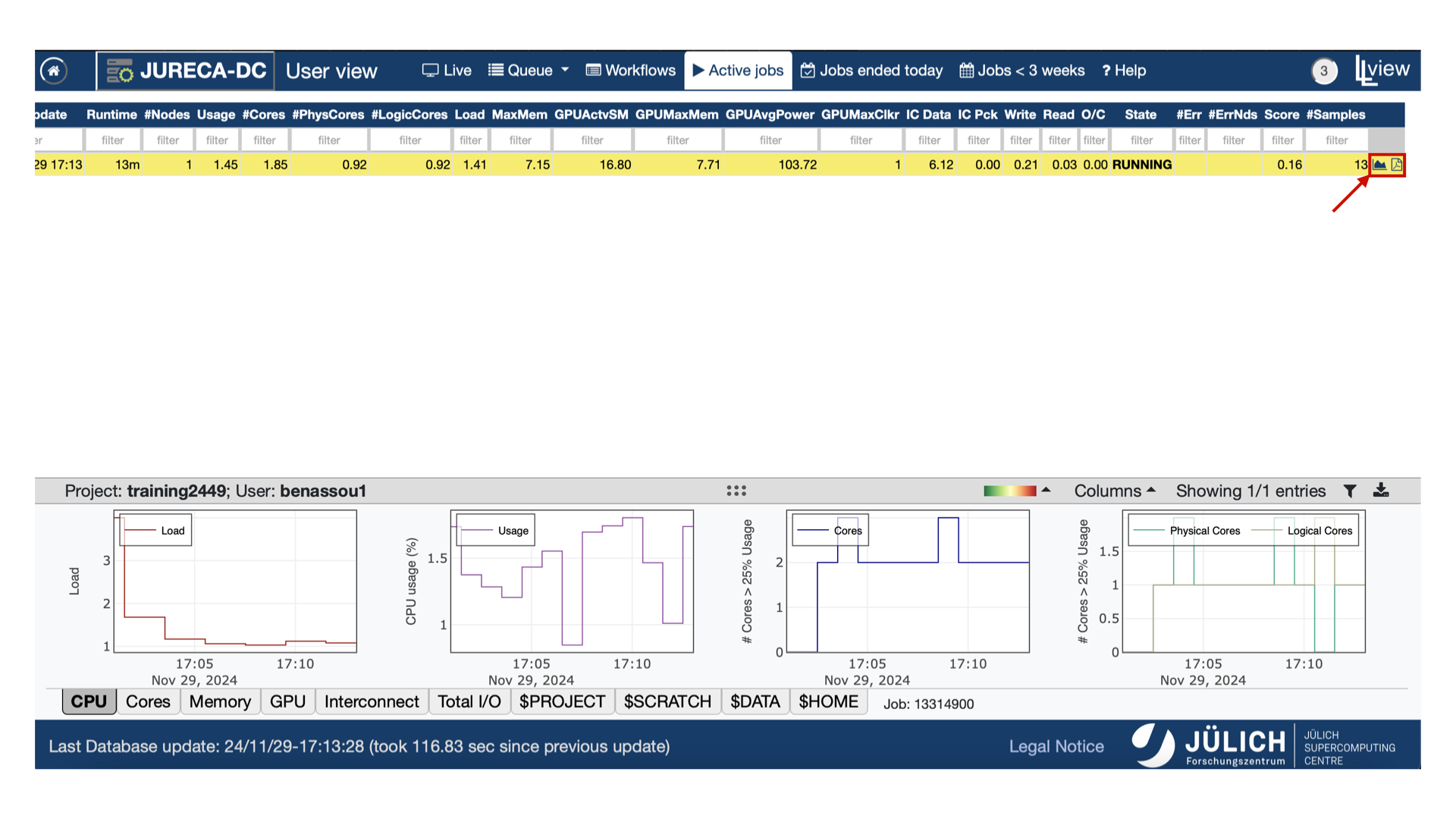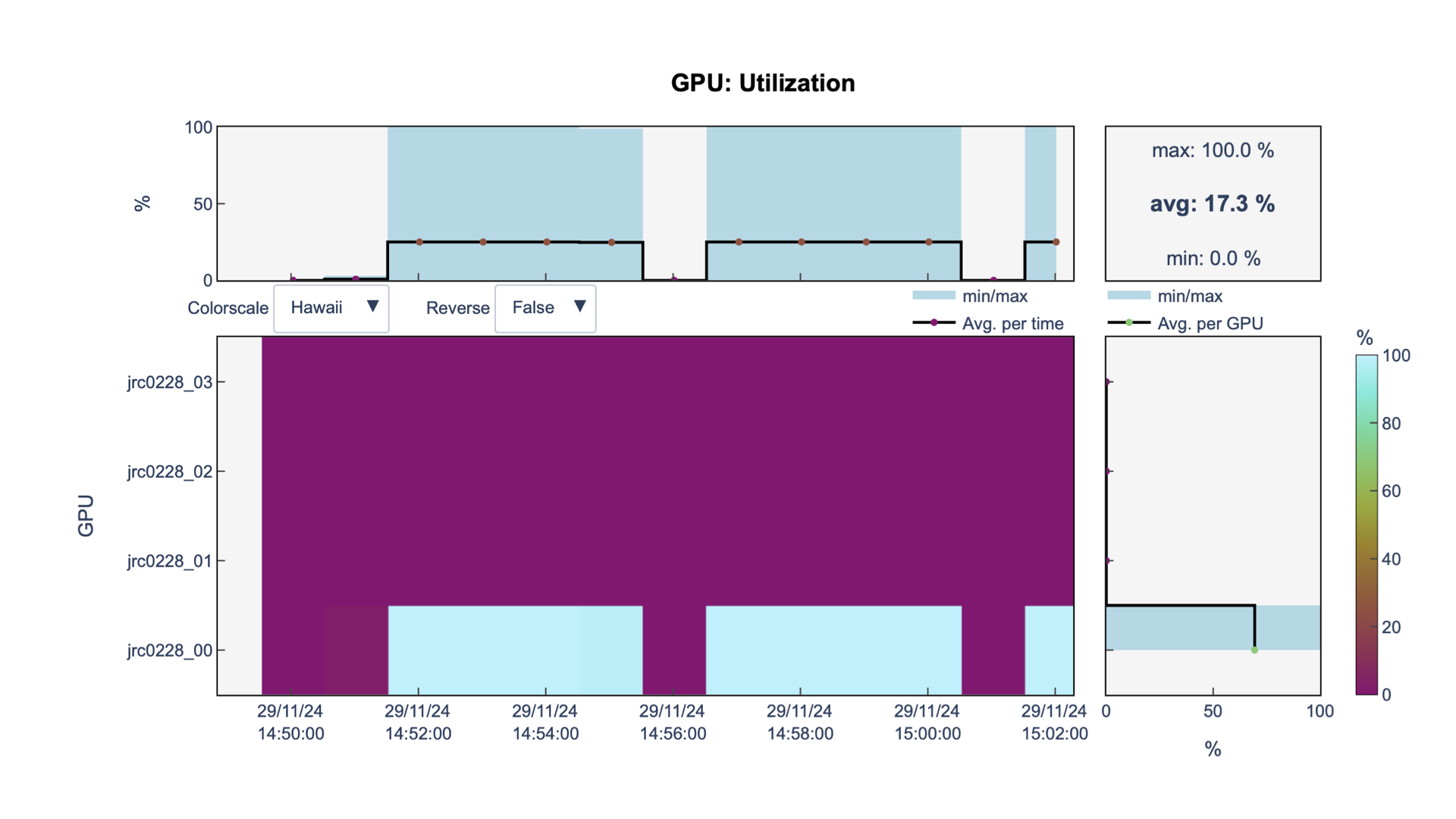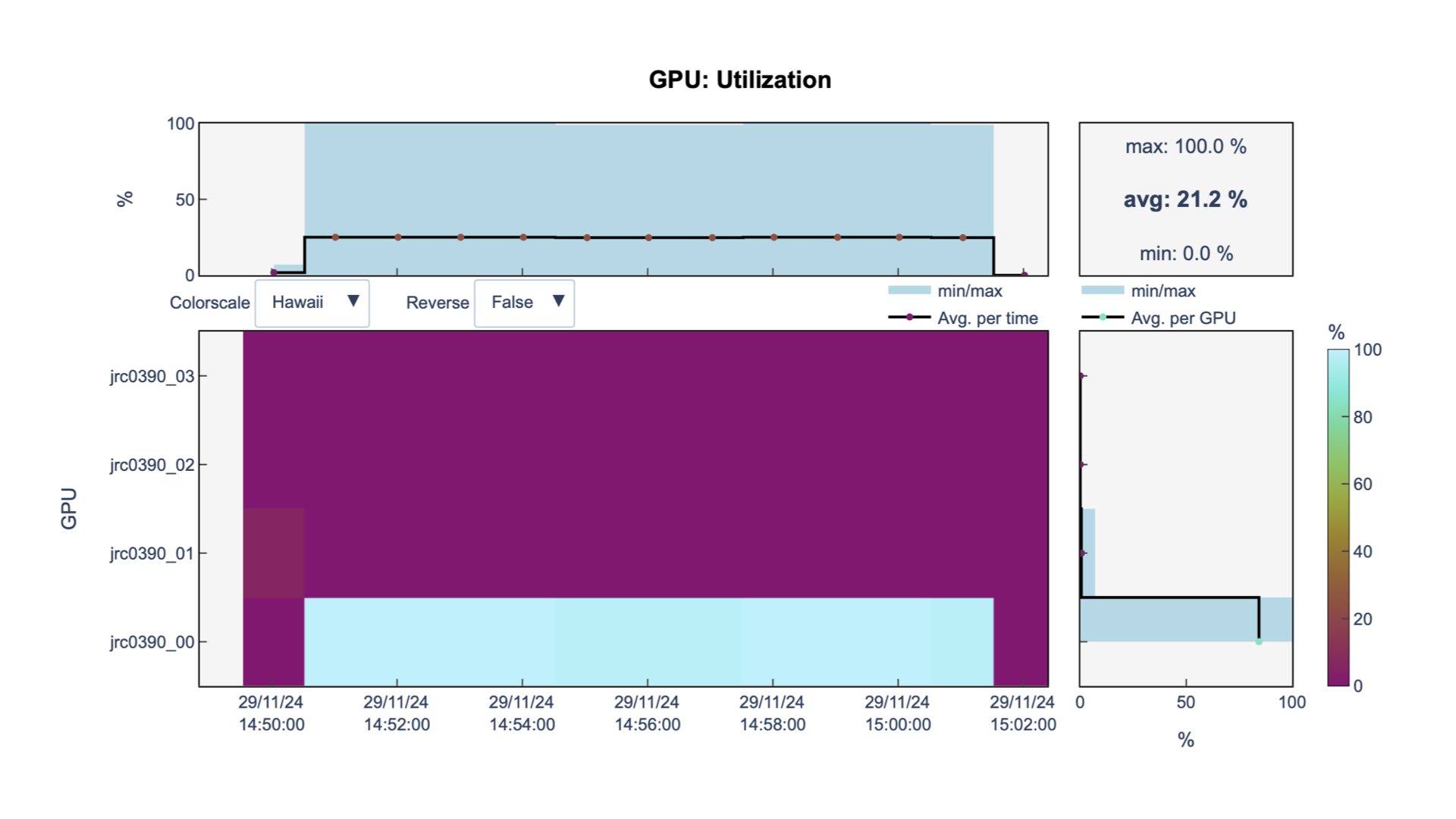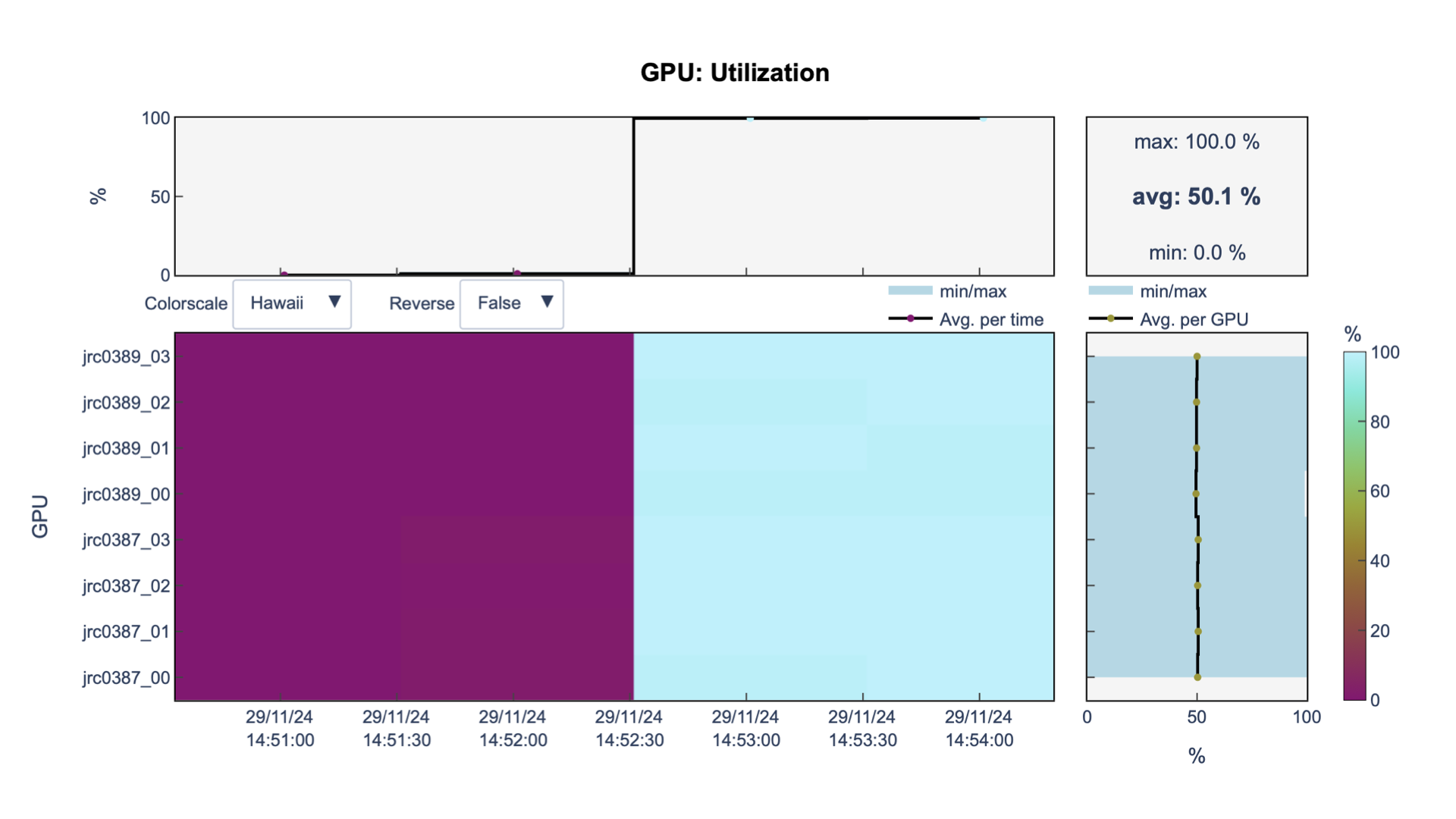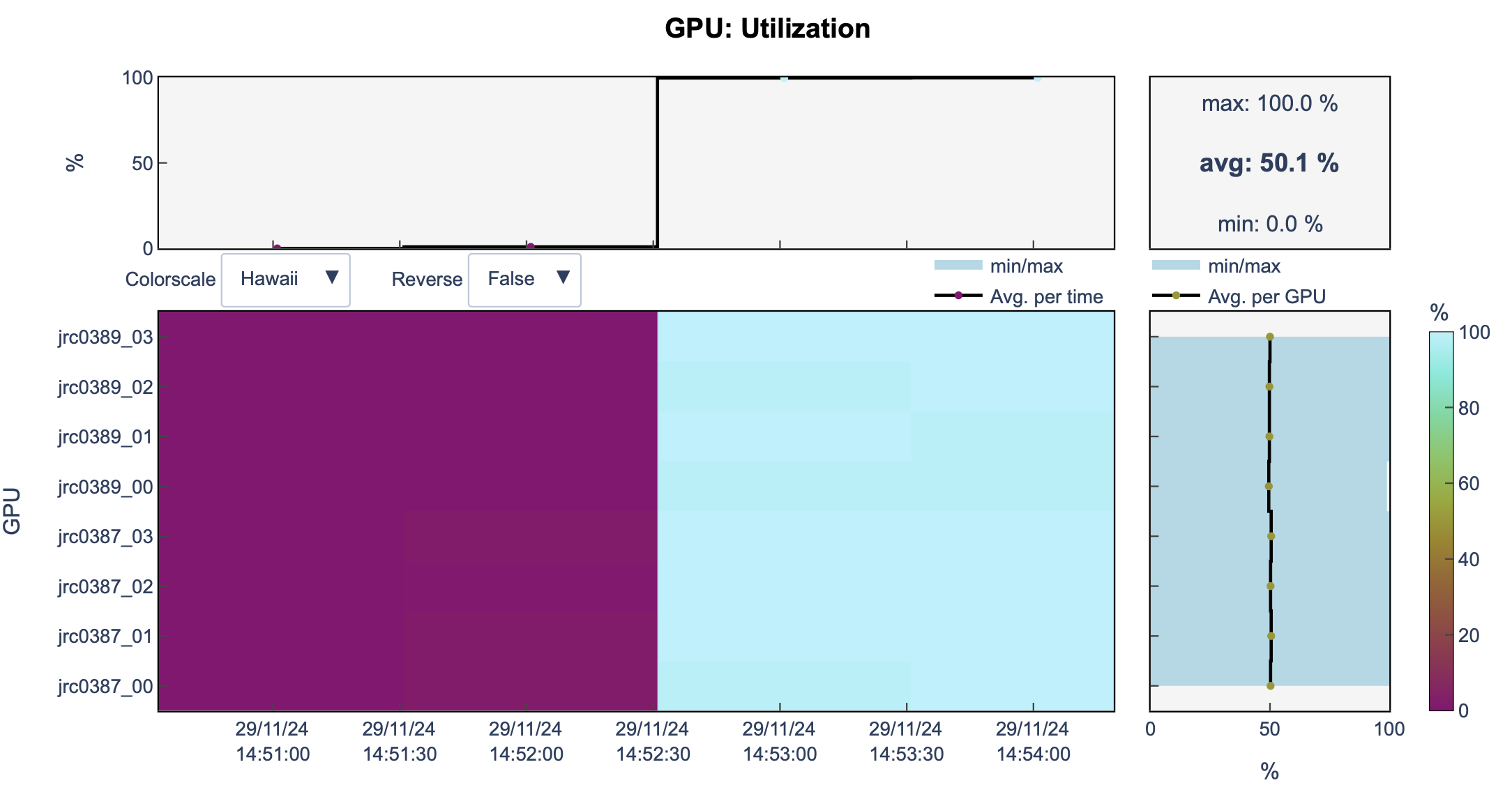Bringing Deep Learning Workloads to JSC supercomputers
Parallelize Training
Alexandre Strube // Sabrina Benassou // José Ignacio Robledo
December 5th, 2024
Before Starting
Move to the correct folder
What this code does
- It trains a transformer model on the xsum dataset to summarize documents.
- Transformers is a deep learning model architecture that uses self-attention to process sequences in parallel.
- XSum is a dataset for abstractive text summarization, containing news articles and their summaries.
What this code does
Again, this is not a deep learning course.
If you are not familiar with the model and the dataset, just imagine it as a black box: you provide it with text, and it returns a summary.
Libraries
- You already downloaded the libraries yesterday that
we will use today:
- PyTorch: A deep learning framework for building and training models.
- Hugging Face: A platform and library for natural language processing (NLP) models and datasets.
- Transformers: A library by Hugging Face for state-of-the-art NLP models.
Let’s have a look at the files train.py
and run_train.sbatch in the repo.

Run the Training Script
There are TODOs in these two files. Do not modify the TODOs for now. The code is already working, so you don’t need to make any changes at this point.
Now run:
Spoiler alert 🚨
The code won’t work.
Check the output and error files
What is the problem?
- Remember, there is no internet on the compute node.
- Therefore, you should:
Comment out lines 90 to 140.
Activate your environment:
Run:
Uncomment back lines 90-140.
Finally, run your job again 🚀:
JOB Running
- Congrats, you are training a DL model on the supercomputer using one GPU 🎉
llview
- You can monitor your training using llview.
- Use your Judoor credentials to connect.
- Check the job number that you are intrested in.
![]()
llview
- Go to the right to open the PDF document.
It may take some time to load the job information, so please
wait until the icon turns blue.
![]()
llview
- You have many information about your job once you
open the PDF file.
![]()
GPU utilization
You can see that in fact we are using 1 GPU
![]()
GPU utilization
It is a waste of resources.
The training takes time (13m according to llview).
Then, can we run our model on multiple GPUs ?
What if
In file
run_train.sbatch, we increase the number of GPUs at line 3 to 4:And run our job again
llview
We are still using 1 GPU
![]()
We need communication
Without correct setup, the GPUs might not be utilized.
Furthermore, we don’t have an established communication between the GPUs
We need communication
We need communication
collective operations
- The GPUs use collective operations to communicate and share data in parallel computing
- The most common collective operations are: All Reduce, All Gather, and Reduce Scatter
All Reduce
- Other operations, such as min, max, and avg, can also be performed using All-Reduce.
All Gather
Reduce Scatter
Terminologies
- Before going further, we need to learn some terminologies
World Size
Rank
local_rank
Now
That we have understood how the devices communicate and the terminologies used in parallel computing, we can move on to distributed training (training on multiple GPUs).
Distributed Training
- Parallelize the training across multiple nodes,
- Significantly enhancing training speed and model accuracy.
- It is particularly beneficial for large models and computationally intensive tasks, such as deep learning.[1]
Distributed Data Parallel (DDP)
DDP is a method in parallel computing used to train deep learning models across multiple GPUs or nodes efficiently.
DDP
DDP
DDP
DDP
DDP
DDP
DDP
DDP
If you’re scaling DDP to use multiple nodes, the underlying principle remains the same as single-node multi-GPU training.
DDP
DDP recap
- Each GPU on each node gets its own process.
- Each GPU has a copy of the model.
- Each GPU has visibility into a subset of the overall dataset and will only see that subset.
- Each process performs a full forward and backward pass in parallel and calculates its gradients.
- The gradients are synchronized and averaged across all processes.
- Each process updates its optimizer.
Let’s start coding!
Whenever you see TODOs💻📝, follow the instructions to either copy-paste the code at the specified line numbers or type it yourself.
Depending on how you copy and paste, the line numbers may vary, but always refer to the TODO numbers in the code and slides.
Setup communication
- We need to setup a communication among the GPUs.
- For that we would need the file
distributed_utils.py. - TODOs💻📝:
Import
distributed_utilsfile at line 13:Then remove lines 77 and 78:
and add at line 77 a call to the method
setup()defined indistributed_utils.py:
Setup communication
What is in the setup() method ?
def setup():
# Initializes a communication group using 'nccl' as the backend for GPU communication.
torch.distributed.init_process_group(backend='nccl')
# Get the identifier of each process within a node
local_rank = int(os.getenv('LOCAL_RANK'))
# Get the global identifier of each process within the distributed system
rank = int(os.environ['RANK'])
# Creates a torch.device object that represents the GPU to be used by this process.
device = torch.device('cuda', local_rank)
# Sets the default CUDA device for the current process,
# ensuring all subsequent CUDA operations are performed on the specified GPU device.
torch.cuda.set_device(device)
# Different random seed for each process.
torch.random.manual_seed(1000 + torch.distributed.get_rank())
return local_rank, rank, deviceModel
TODO 4💻📝:
At line 83, wrap the model in a DistributedDataParallel (DDP) module to parallelize the training across multiple GPUs.
DistributedSampler
TODO 5💻📝:
At line 94, instantiate a DistributedSampler object for each set to ensure that each process gets a different subset of the data.
# DistributedSampler object for each set to ensure that each process gets a different subset of the data. train_sampler = torch.utils.data.distributed.DistributedSampler(train_dataset, shuffle=True, seed=args.seed) val_sampler = torch.utils.data.distributed.DistributedSampler(val_dataset) test_sampler = torch.utils.data.distributed.DistributedSampler(test_dataset)
DataLoader
TODO 6💻📝:
At line 103, REMOVE
shuffle=Truein the DataLoader of train_loader and REPLACE it bysampler=train_sampler
DataLoader
TODO 7💻📝:
At line 108, pass val_sampler to the sampler argument of the val_dataLoader
TODO 8💻📝:
At line 112, pass test_sampler to the sampler argument of the test_dataLoader
Sampler
TODO 9💻📝:
At line 125, set the current epoch for the dataset sampler to ensure proper data shuffling in each epoch
All Reduce Operation
TODO 10💻📝:
At lines 49 and 72, Obtain the global average loss across the GPUs.
TODO 11💻📝:
At lines 133, 144, and 148, replace all the
printmethods byprint0method defined indistributed_utils.pyto allow only rank 0 to print in the output file.# We use the utility function print0 to print messages only from rank 0. print0(f'[{epoch+1}/{args.epochs}] Train loss: {train_loss:.5f}, validation loss: {val_loss:.5f}')
The definition of the function print0 is in
distributed_utils.py
Save model
TODO 12💻📝:
At lines 138 and 151, replace torch.save method with the utility function save0 to allow only the process with rank 0 to save the model.
Save model
The method save0 is defined in
distributed_utils.py
functools.lru_cache(maxsize=None)
def is_root_process():
"""Return whether this process is the root process."""
return torch.distributed.get_rank() == 0
def save0(*args, **kwargs):
"""Pass the given arguments to `torch.save`, but only on the root
process.
"""
# We do *not* want to write to the same location with multiple
# processes at the same time.
if is_root_process():
torch.save(*args, **kwargs)We are almost there
- That’s it for the train.py file.
- But before launching our job, we need to add some lines to run_train.sbatch file
Setup communication
In run_train.sbatch file:
- TODOs 13💻📝:
At line 3, increase the number of GPUs to 4 if it is not already done.
At line 22, pass the correct number of devices.
Setup communication
Stay in run_train.sbatch file:
TODO 14💻📝: we need to setup MASTER_ADDR and MASTER_PORT to allow communication over the system.
At line 24, add the following:
# Extracts the first hostname from the list of allocated nodes to use as the master address. MASTER_ADDR="$(scontrol show hostnames "$SLURM_JOB_NODELIST" | head -n 1)" # Modifies the master address to allow communication over InfiniBand cells. MASTER_ADDR="${MASTER_ADDR}i" # Get IP for hostname. export MASTER_ADDR="$(nslookup "$MASTER_ADDR" | grep -oP '(?<=Address: ).*')" export MASTER_PORT=7010
Setup communication
We are not done yet with
run_train.sbatch file:
TODO 15💻📝:
At line 35, we change the lauching script to use torchrun_jsc and pass the following argument:
# Launch a distributed training job across multiple nodes and GPUs srun --cpu_bind=none bash -c "torchrun_jsc \ --nnodes=$SLURM_NNODES \ --rdzv_backend c10d \ --nproc_per_node=gpu \ --rdzv_id $RANDOM \ --rdzv_endpoint=$MASTER_ADDR:$MASTER_PORT \ --rdzv_conf=is_host=\$(if ((SLURM_NODEID)); then echo 0; else echo 1; fi) \ train.py "
Setup communication
The arguments that we pass are:
nnodes=$SLURM_NNODES: the number of nodesrdzv_backend c10d: the c10d method for coordinating the setup of communication among distributed processes.nproc_per_node=gputhe number of GPUsrdzv_id $RANDOMa random id which that acts as a central point for initializing and coordinating the communication among different nodes participating in the distributed training.rdzv_endpoint=$MASTER_ADDR:$MASTER_PORTthe IP that we setup in the previous slide to ensure all nodes know where to connect to start the training session.rdzv_conf=is_host=\$(if ((SLURM_NODEID)); then echo 0; else echo 1; fi)The rendezvous host which is responsible for coordinating the initial setup of communication among the nodes.
done ✅
You can finally run:
llview
Let’s have a look at our job using llview again.
You can see that now, we are using all the GPUs of the node
![]()
llview
And that our job took less time to finish training (4m vs 13m with one GPU)
And even the test loss function is lower (0.538 vs 0.636 with one GPU).
But what about using more nodes ?
What about using more nodes ?
Multi-node training
In
run_train.sbatchat line 2, you can increase the number of nodes to 2:Hence, you will use 8 GPUs for training.
Run again:
llview
Open llview again.
You can see that now, we are using 2 nodes and 8 GPUs.
![]()
Amazing ✨
Before we go further…
- Data parallel is usually good enough 👌
- However, if your model is too big to fit into a single GPU
- Welllll … there other distributed techniques …
Fully Sharded Data Parallel (FSDP)
FSDP
FSDP
FSDP
FSDP
FSDP
FSDP
FSDP
FSDP
FSDP
FSDP
FSDP
FSDP
FSDP
FSDP
FSDP
FSDP
FSDP
FSDP
FSDP
FSDP
FSDP
FSDP
FSDP
FSDP
FSDP
FSDP
FSDP
FSDP
FSDP
FSDP
- FSDP is a primitive method in PyTorch.
- Its memory efficiency is high because model parameters, gradients and optimizers are sharded.
- However, it requires a high-bandwidth system because it involves frequent communication between GPUs.
- If you have bandwidth-limited clusters, FSDP may not be ideal, and you would prefer pipelining technique.
Model Parallel
- Before talking about pipelining, let’s talk about Model Parallelism (MP).
- Model itself is too big to fit in one single GPU 🐋
- Each GPU holds a slice of the model 🍕
- Data moves from one GPU to the next
Model Parallel
Model Parallel
Model Parallel
Model Parallel
Model Parallel
Model Parallel
Model Parallel
Model Parallel
Model Parallel
Model Parallel
Model Parallel
What’s the problem here? 🧐
Model Parallel
- Waste of resources
- While one GPU is working, others are waiting the whole process to end
![]()
Model Parallel - Pipelining
Model Parallel - Pipelining
Model Parallel - Pipelining
Model Parallel - Pipelining
Model Parallel - Pipelining
Model Parallel - Pipelining
Model Parallel - Pipelining
Model Parallel - Pipelining
Model Parallel - Pipelining
This is an oversimplification!
- Actually, you split the input minibatch into multiple microbatches.
- There’s still idle time - an unavoidable “bubble” 🫧
![]()
Model Parallel - Multi Node
- In this case, each node does the same as the others.
- At each step, they all synchronize their weights.
Model Parallel - Multi Node
Pipeline Parallelism
- Pipeline parallelism does not require frequent communication because the model is stored sequentially in stages.
- If your model is computationally intensive with extremely wide layers, you may consider Tensor Parallelism (TP).
Tensor Parallelism (TP)
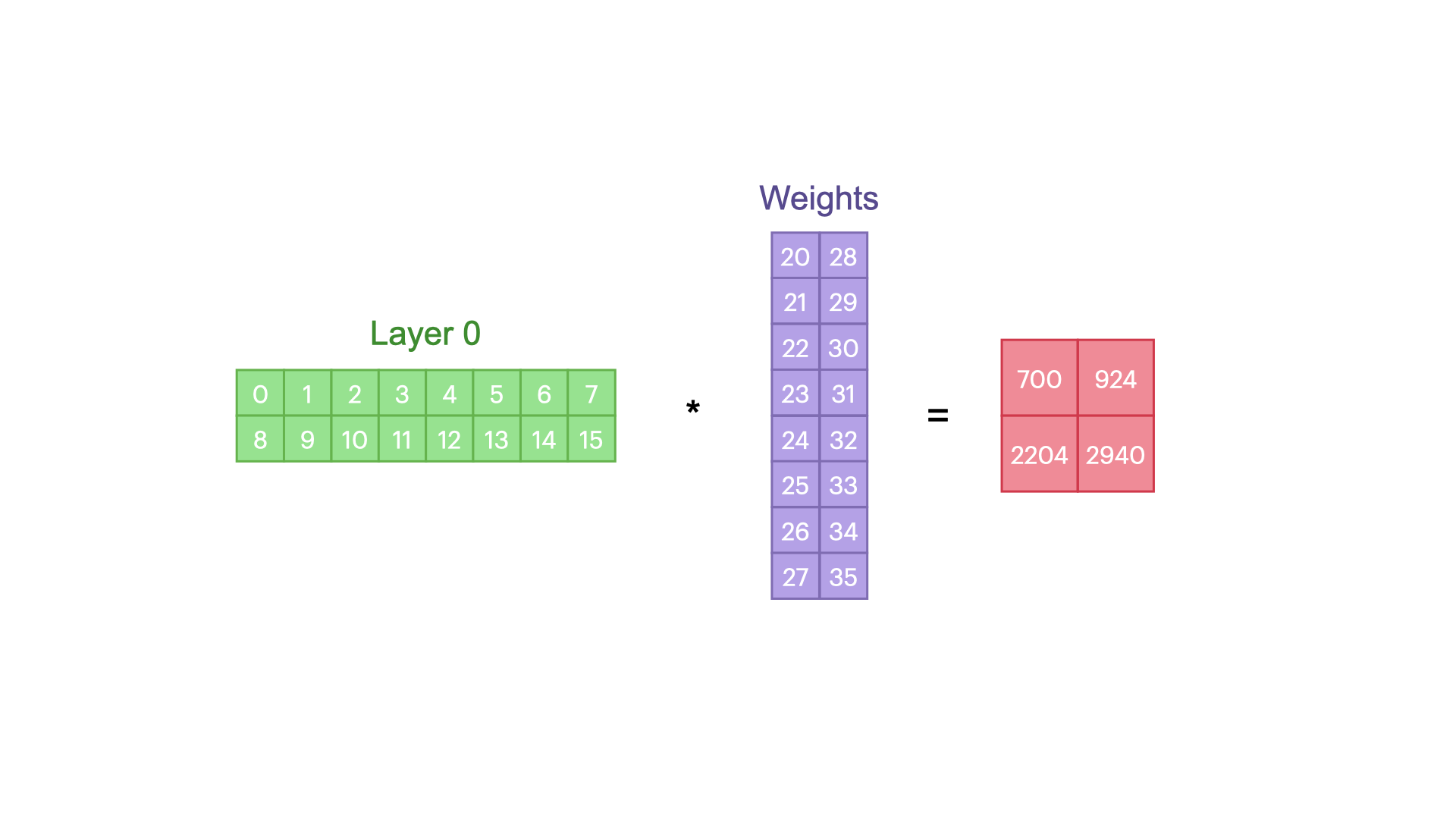
TP
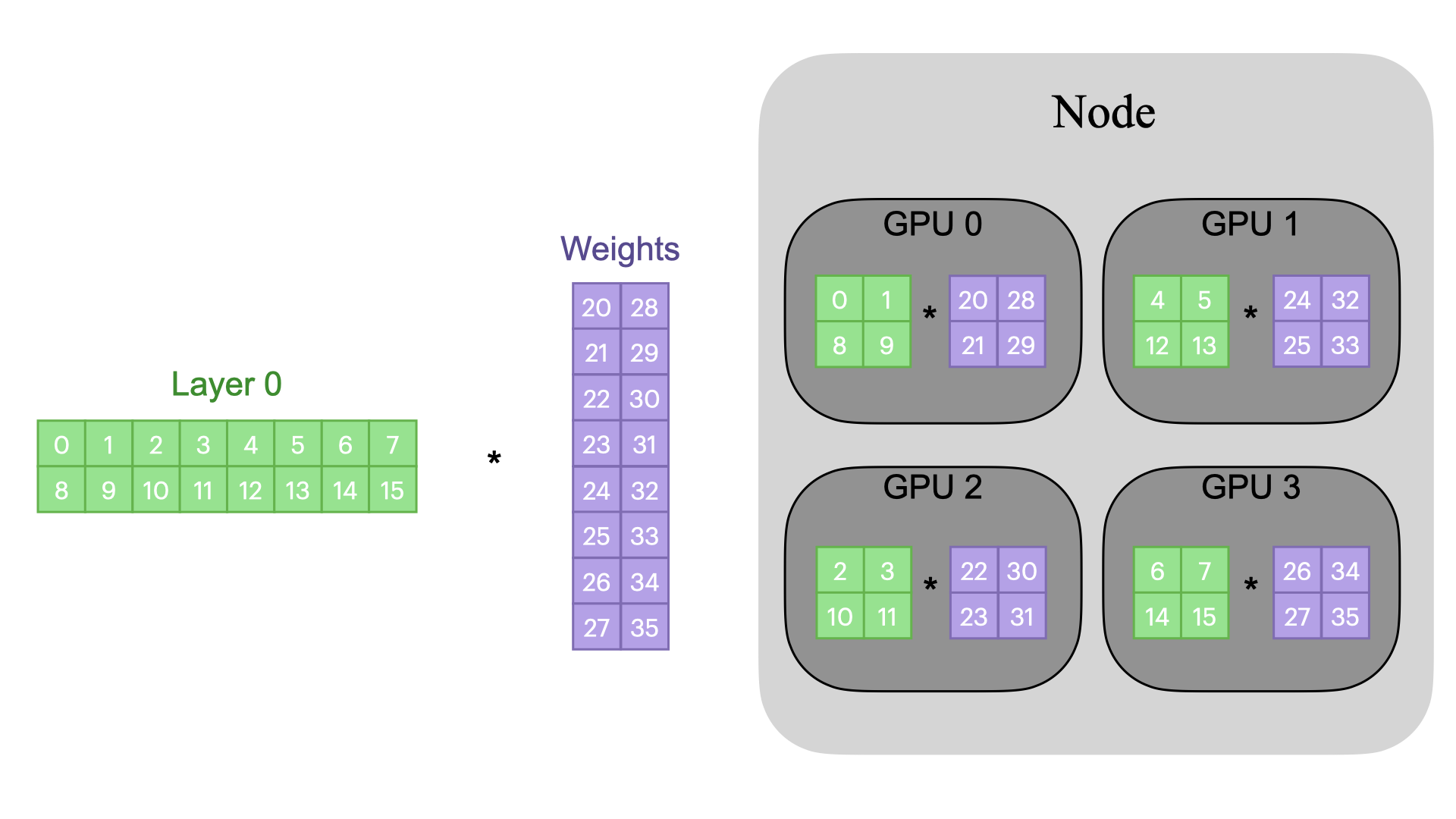
TP
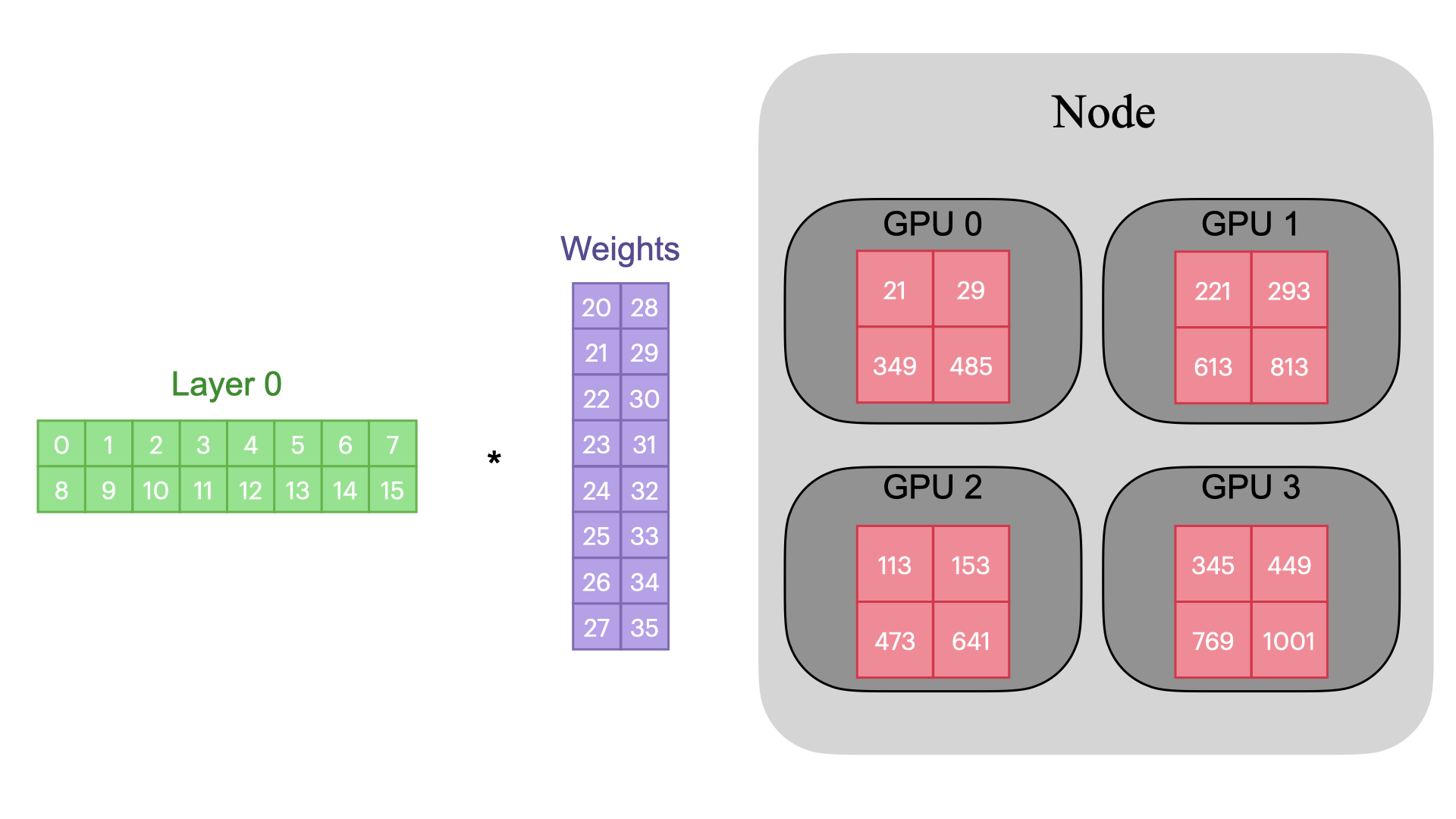
TP
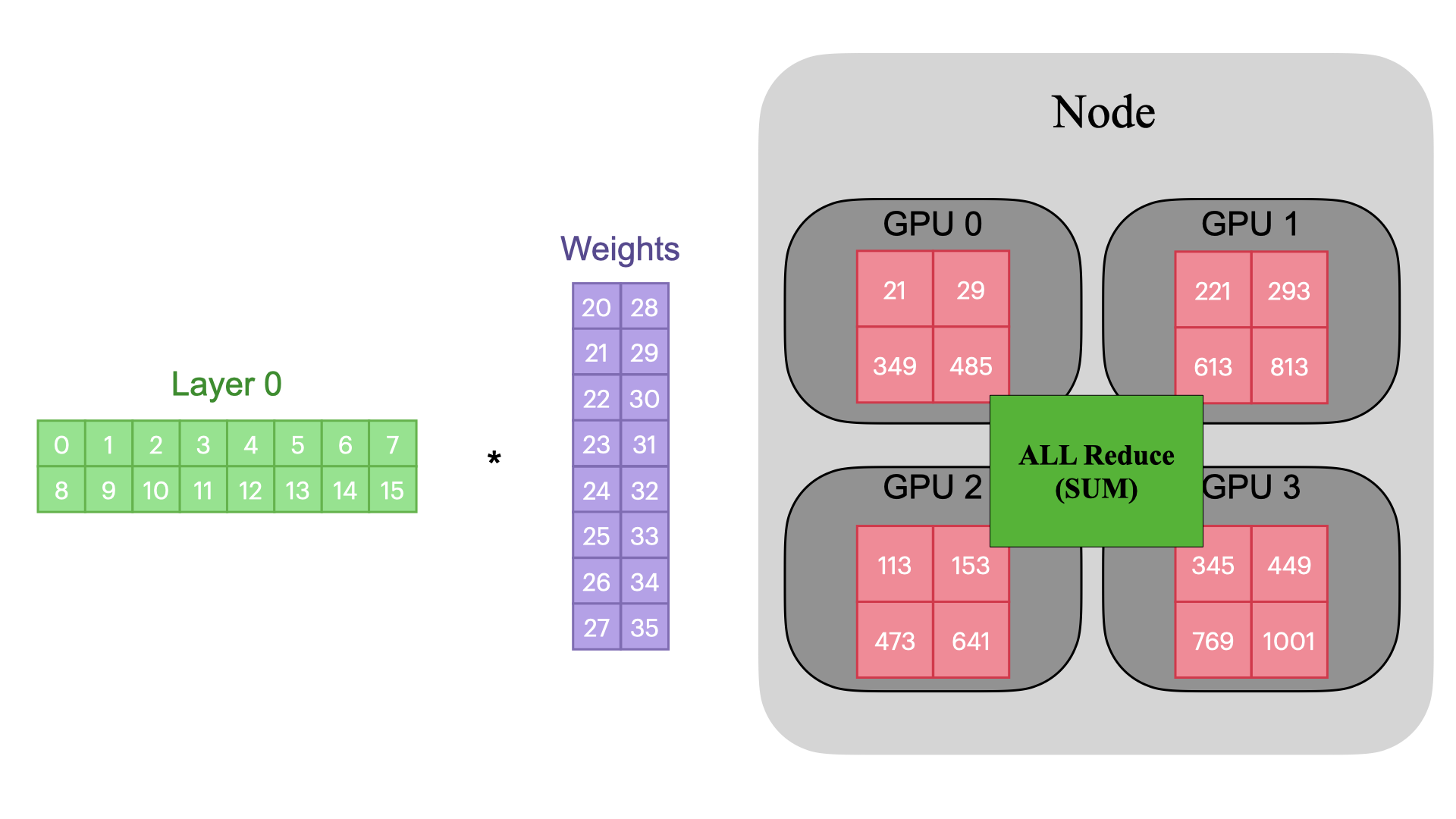
TP
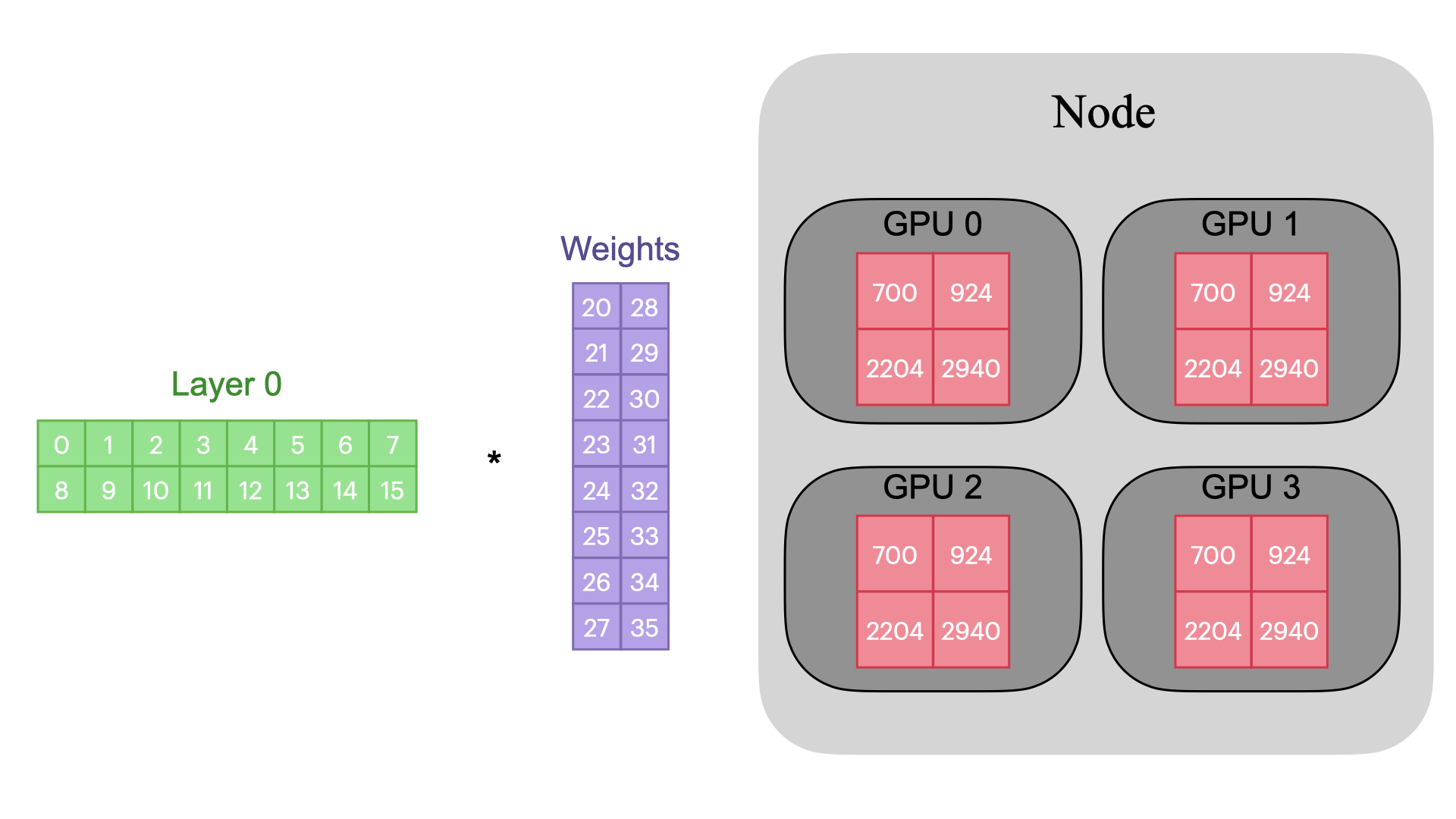
TP
- We have introduced row parallelism.
- There is also column parallelism, where the weight columns are split across GPUs.
- Tensor Parallelism (TP) is great for large, compute-heavy layers like matrix multiplications.
- However, TP requires frequent communication during tensor operations.
3D Parallelism

- 3D Parallelism combines Tensor Parallelism (TP), Pipeline Parallelism (PP), and Data Parallelism (DP) to efficiently train large models by distributing computation, memory, and data across multiple GPUs.
- It enables scaling to very large models by addressing compute, memory, and communication bottlenecks in a balanced way.
Day 2 RECAP
- You know where to store your code and your data. 🗂️
- How to create HDF5 and PyArrow files. 📄
- You know what distributed training is. 🧑💻
- You can submit training jobs on a single GPU, multiple GPUs, or across multiple nodes. 🎮💻
- You are familiar with DDP and aware of other distributed training techniques like FSDP, TP, PP, and 3D parallelism. ⚙️💡
- You know how to monitor your training using llview. 📊👀
Find Out More
Here are some useful:
